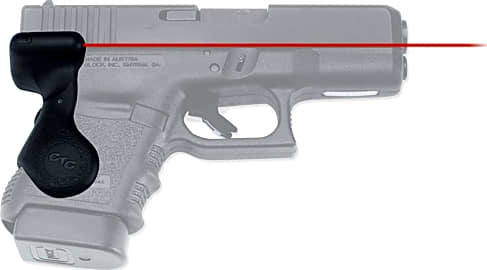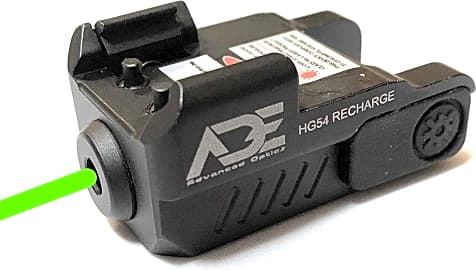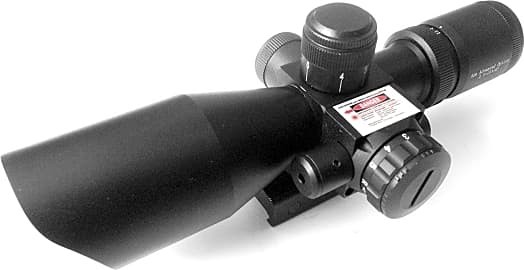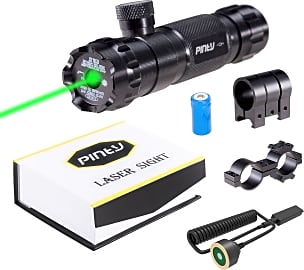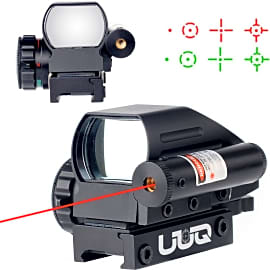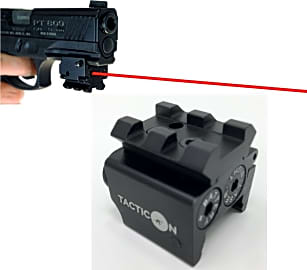The 10 Best Laser Scopes

This wiki has been updated 43 times since it was first published in December of 2015. If you're going to shoot at something, you want to make sure you hit it. Right? These laser scopes make it a lot easier to acquire a target accurately, and are good for both sporting and tactical applications from hunting to paintball. All of our choices can stand up to heavy-duty use, and we've ranked them here by their accuracy, ease of adjustment, sighting options, and durability. When users buy our independently chosen editorial selections, we may earn commissions to help fund the Wiki.
Editor's Notes
February 25, 2020:
A few of the models included on our previous list had some availability problems, and the Cisno Quick-Release has particularly hard-to-reach adjustment points that could cost you a quality shot if a target arrived and you weren't ready. We removed those from our list, replacing them with some really fine options like the Sniper FL3000 Tactical, which offers both a green and infrared beam for use in daylight or at night with night vision goggles.
We also added a few options to the special honors section, two of which are still in the relative price range of the rest of the list, and one of which — from Burris — is significantly more expensive, but offers the kind of quality you'd want in a professional grade scope, including a long zoom range, wide 50mm objective, and outstanding optical performance.
Special Honors
Barska AU12394 Flashlight For tactical ops that need more illumination than a green dot can offer, this model is a nice investment. It's primary component is a 200-lumen flashlight that's augmented by the five-milliwatt beam, and it secures nicely to the underside of most pistols. It also boasts a pressure sensitive activation switch, but it is a little bit bulky, though. barska.com
BSA Optics 30mm This model offers a lot for a relatively low price, including nine levels of brightness adjustment and an easy-to-use one-piece weaver mount. It's also covered by a one-year warranty and comes with a detachable flashlight. The one thing it doesn't have going for it is any kind of magnification, which could be a deal breaker for some. bsaoptics.com
Burris Eliminator III If you're in the market for a professional targeting aid, this is undoubtedly it. You'll pay a premium for it, but it will provide you with a 4-16 zoom range, a 50mm objective lense that performs very well in low light, and fogproof and water-resistant construction for use in a variety of field conditions. sportoptics.com
On Target: Choosing A Laser Scope
Laser scopes make it quick and easy for a person to line up an accurate shot whether armed with a pistol, rifle, or even a shotgun.
Laser scopes make it quick and easy for a person to line up an accurate shot whether armed with a pistol, rifle, or even a shotgun. Once a laser has been properly sighted in to assure its accurate alignment with the weapon's barrel, a shooter can rely on the placement of the bright red or green dot cast by their laser to predict the placement of a fired bullet. Laser scopes represent one of the most practical applications of the amazing power of the laser (more on that below), and their proper use can truly alter the course of a life or death situation.
The term laser "scope" is a bit misleading, as technically a scope is an optical device through which you can peer. Laser scopes are often also referred to as laser "sights," a term also slightly fraught with inaccuracy, as it were. The beauty of a laser scope is indeed the very fact that you do not have to look through any form of sighting device to be assured of the accuracy of your aim. A laser scope allows its user to keep his or her eyes open and largely away from their firearm, helping the shooter to maintain the situational awareness critical in self defense scenarios, in combat, or during police action.
That said, many laser scopes combine a visual sighting device through which a shooter can look with a bright dot created by the laser. The combination of these two sight picture options not only helps to create reliably accurate aim, but also ensures a weapon remains useful in more than one scenario. A rifle which has both an optical scope and a laser sight, for example, can be used in the slow, patient hands of a hunter or sniper, but can also be used for quick, close-quarters response when the laser is activated.
When choosing the right laser scope for your needs, both the likely scenarios in which you will use your weapons and the type of gun(s) you own are equal factors. Choosing a device that combines a laser sight and a flashlight can also be a wise idea for both rifles and shotguns intended for self defense, as the light can help you differentiate between friend and foe at close range in the dark.
For rifles, however, a scope mixing a laser and an optical sight is almost always the right approach. Even the most powerful lasers available usually have a maximum operating range of 500 meters, which is well short of the accurate range of most high powered rifles; therefore, without the addition of an optical scope, you would not be able to make use of the capabilities of your long gun.
Safe And Proper Laser Scope Usage
The most important factor in using a laser scope safely is making sure you are properly using the firearm to which it is attached. That means using everything from a gun safe when the weapon is not being used, transported, or cleaned, to wearing ear protection and shooting glasses when you are at the shooting range or hunting.
Take the time to properly sight in your weapon once the laser scope is attached.
Take the time to properly sight in your weapon once the laser scope is attached. If need be, enlist the help of a professional firearms expert to complete this process. Once a laser sight is accurately aligned with your weapon, take care that you don't bump or jostle it, and make sure to re-check your accuracy periodically.
Beyond proper and ongoing firearm safety, it's important to note that using the laser itself requires care and responsibility. Even a laser that creates only a three to five milliwatt output — the standard range for most laser scopes that produce red lasers — can likely cause eye damage. And many of the stronger lasers that produce a green beam can surely damage the eye even with brief exposure. While it's not likely you would ever have a laser inadvertently pointed at someone once it is mounted to a firearm, you have to observe safe and responsible use of your aiming device even when it is detached from a gun.
Also, note that using a laser scope — and even using a handheld laser pointer — is restricted or even banned in some areas. Be especially vigilant about following laser regulations at night time in areas where there are numerous aircraft in the skies, as lasers can easily distract pilots, and as their improper use can lead to punitive action by the authorities.
A Few Words On Laser Technology
Lasers are a relatively new technological advance. In fact, the first laser was built in the year 1960, though its development was predicated by scientific research conducted over many of the preceding years. The word laser was originally an acronym for the term "Light Amplification by Stimulated Emission of Radiation," though today it is treated as a word unto itself.
In fact, the first laser was built in the year 1960, though its development was predicated by scientific research conducted over many of the preceding years.
Lasers work through a process of "optical amplification" wherein electrons are passed through a series of lenses, crystals, and/or contained gasses and become increasingly concentrated, ultimately forming a distinct beam of photons that can be focused. Unlike sunlight or the light generated by most artificial illumination sources, such as an incandescent lightbulb, lasers emit just one wavelength, therefore they are perceived as one solid, definite color (red and green being the most common).
Due to the intense concentration of the light used in most practical lasers (those used in a laser scope, for our purposes), minimal energy can be used to create a bright and far-reaching laser beam. For clarity, the five milliwatt figure cited above represents less than one percent of one percent of the power used by a standard 60-watt lightbulb that you would place in a desk lamp. Yet thanks to the properties of immense concentration at work within a laser, the beam created using that minuscule amount of power can reach out for hundreds of yards under the right conditions.




